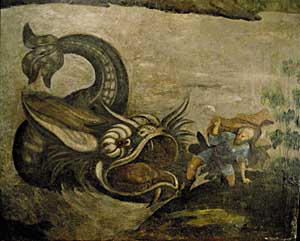Exile and Restoration in the Death and Resurrection of Christ
I wonder if many find their reading of the Old Testament hindered, in part, because they have not adequately come to understand that the judgment/salvation scheme of the Old Testament (consisting in typical judgments and typical restorations) were pictures of what Christ would experience for His people in His death, and of the typical restorations that served as pictures of the resurrection of Christ, and of believers in Him. In short, every picture of judgment and salvation–of exile and restoration–are pictures of the death and resurrection of Christ. Whether it was (1) the judgment of the world in Noah’s day, followed by the newly created world that he and his children stepped off of the Ark to inhabit, or (2) the judgment on Babel, followed by the calling of Abraham and the creation of the covenant people, or (3) the judgment that fell on Egypt (culminating in death in the Red Sea) and the salvation of Israel coming out of that Sea (resurrection) as a typical new creation; or (4) the typical judgment-death of Jonah in the belly of the fish, and his subsequent typical restoration-resurrection from the place of the dead; or (5) the judgment-exile that Israel experienced in the Babylonian captivity, which ended in their restoration to the land–God was always foreshadowing the saving work of Jesus for His people.
There are two structuring judgment-exiles in the Old Testament. The first judgment-exile in Scripture was that of Adam and Eve from the Garden-Temple paradise. The second exile of the Scriptures is that of Israel being driven out of the Garden-Temple Land. The story of the Bible is a record of the second Adam and true Israel, Jesus Christ, coming to restore, redeem and secure that which Adam and Israel failed to secure. Both Adam and Israel were called “God’s son” (Luke 3:38; Ex. 4:22). Jesus is the eternal Son of God who obeyed in every way that Adam and Israel failed, and who took the judgement-curse upon Himself for our disobedience. He then rose in victorious triumph to bring in the New Heavens and New Earth for all those He represented.




Thank you. You’ve put it in words beautifully. This needs to be taught more.
Good stuff Nick. Do you have any thoughts on those brought out of Egypt that were not allowed to enter the Promised Land? Were they “saved”?
Steve, I understand the salvation of Noah and his family, and Israel being brought out of Egypt as typical salvation. So, it seems from Scriptures that many of those who were redeemed out of Egypt, in that typical redemption, did not enter into God’s eternal rest. This brings us into the whole discussion of the visible/invisible church distinction (i.e. the internal/external administration of the covenant). Is this helpful, or more confusing?
Thanks Nick it is helpful. What do you think about Moses, who doesn’t enter the Promised Land because of his disobedience, but seems to be “saved” (Heb. 11,12). Is the Promised Land an imperfect shadow/type of Heaven, or could it be a type of some other present earthly state that believers can enter in to or fail to enter in to by disobedience, or something else altogether?